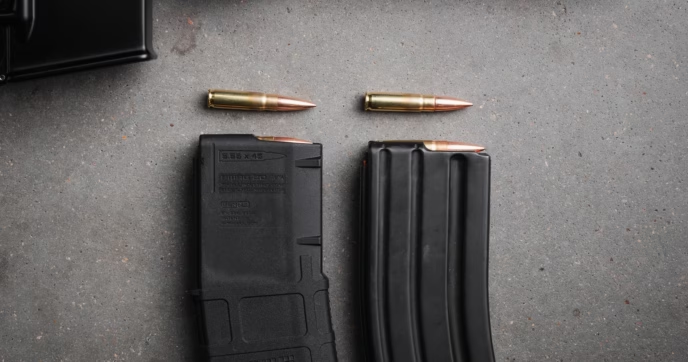AR-15s are offered in a greater variety of calibers than nearly any other firearm platform in the world. Ranging from training-friendly .22LR up to the budget-busting .458 Socom, each of these cartridges offers different strengths and serves a different role.

What Is Caliber?
Technically, caliber only refers to the internal diameter of the rifle’s barrel—basically, the size of the bullet. This can be misleading since multiple different cartridges can utilize the same caliber without being interchangeable, such as .223 and .22-250.
In many cases, this one included, we’re actually talking about different cartridges or chamberings when we talk about caliber. “Cartridge” refers to the full specifications of ammunition, rather than just the diameter of the bullet. “Caliber” and “Cartridge” are often used interchangeably in conversation, despite the technical differences, but when shopping for ammunition it’s important to know the difference.

The Different Types of AR-15 Calibers/Cartridges
AR-15s are available chambered in nearly every cartridge that will physically fit into the receiver, so we won’t be able to cover every single option here, but below we’ll review some of the most common choices.
.223 Remington/5.56 NATO
While these are actually two distinct cartridges, they are so similar that in most cases, they are interchangeable. Most AR-15s are marked for 5.56, which can use either .223 or 5.56. If your rifle is marked for .223, you should always refer to the manual before using 5.56, as not all .223 rifles are designed to handle 5.56 and can suffer catastrophic damage if loaded improperly.
These cartridges are often considered the standard for the AR-15 since they are the original chambering. 5.56 NATO is still used to this day by military and police units the world over.
Both cartridges utilize a small, lightweight bullet pushed at very high velocities to create an effective all-purpose round that can be used for small- and medium-game hunting, home defense, competition, plinking—nearly anything you can use a rifle for.
.300 Blackout
The .300 Blackout is a specialized round developed primarily to address some of the limitations of the 5.56 NATO cartridge. Since 5.56 NATO relies on its high velocity to be effective, subsonic or low-velocity ammunition for use with suppressors is severely underpowered.
.300 Blackout remedies this issue by expanding the neck of a 5.56 NATO brass casing to be able to accept a much larger, heavier bullet. The increased weight of the bullet allows it to be fired at lower velocities while still maintaining enough energy to be effective at short-to-medium ranges. In combination with a suppressor, the .300 Blackout is capable of exceptionally quiet shots.
This cartridge is available in both supersonic and subsonic velocities, but both suffer from a shorter effective range than .223/5.56. Additionally, .300 Blackout is generally more expensive.
Most .300 Blackout AR-15 components are completely interchangeable with .223/5.56 AR-15s, including both the bolt carrier group and magazine. Only the barrel and muzzle device differ.
6.5 Grendel
This cartridge was born out of a desire to increase the effective range of the AR-15, and it succeeded. A popular AR-15 caliber for hunting, the 6.5 Grendel uses a larger and heavier round, not unlike the .300 Blackout, but also uses a larger case to hold more powder.
The result is an exceptionally flat shooting round with a high ballistic coefficient, allowing it to reach further distances than .223/5.56 and better resist wind drift. 6.5 Grendel is often selected for its long-range performance, as well as its higher muzzle energy, making it a solid choice for medium-game hunting.
Shop All AR-15 Upper Receivers
It does require a proprietary barrel, bolt carrier group, and magazine though, making it a more expensive option to convert to than .300 Blackout. Additionally, as with .300 Blackout, 6.5 Grendel ammo is more expensive than most .223/5.56 offerings.
.458 SOCOM
A highly specialized round developed for use by US Special Forces, the .458 SOCOM is optimized for close-quarters performance above all else. It’s a truly massive bullet at nearly half an inch in diameter and up to 600 grains in weight—over ten times the weight of a standard .223/5.56 bullet. It’s not the biggest caliber for an AR-15, but it’s close.
The .458 SOCOM delivers enormous muzzle energy but drops precipitously at range, limiting it to short-range use almost exclusively. Its size also results in a significantly reduced magazine capacity, fitting only 10 rounds in a standard .223/5.56 magazine.
While certainly packing enough energy to be an effective hunting round, its large size means that it is often eschewed by hunters in favor of a smaller-caliber cartridge that will damage less of the meat of the animal.

Conclusion
AR-15s are some of the most versatile firearms in existence. They’re available in a truly staggering array of calibers and cartridges, and often can be switched between them by merely swapping a few parts.
.223/5.56 has long been the standard, and for good reason; it’s an extremely well-rounded cartridge with a wide variety of applications. For more specialized tasks, though, purpose-built rounds like the .300 Blackout, 6.5 Grendel, and .458 SOCOM are excellent options.



